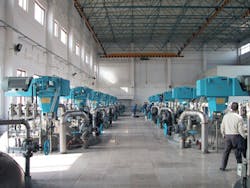Kevin Walsh is the director of marketing and product management at Chemineer Inc., where he has worked in various applications and sales positions since 1988. Mr. Walsh holds a bachelor’s degree in Chemical Engineering and master’s degree in Materials Engineering, both from the University of Dayton. Chemineer is a manufacturer of rotating and static mixers used in various markets throughout the world.
Q: What do you see as the key technology enhancements over the past 10-20 years in the mixers category? How are the mixing technologies of today more effective than the mixing technologies of the past?
A: Key technological advances in mixing include new impeller designs such as wide-blade hydrofoils, counter-flow impellers, concave impellers, ragless impellers, pumper impellers, etc., which are applied to improve specific applications and processes such as solids suspension, transitional flow, gas dispersion/fermentation, draft tubes/crystallizers, PTA oxidation reactors, solvent extraction, waste treatment, and more.
Advances in the use of computational fluid fixing (CFM); improved drive designs such as features specific to handle the loads in agitator service; enhanced sealing technology; process-specific static mixing elements; service and installation offerings to meet changing demands; and increased use of computerized design/optimization programs by vendors and customers have also been implemented over the past couple decades.
Technologies are more effective by applying specific impellers and static mixer elements to enhance and solve mixing applications rather than using a general design approach, as was the case in the past. Mixing companies also have a variety of computer-aided design tools, such as computational fluid mixing, finite element analysis (FEA), and interactive design programs to optimize a mixing selection that is more effective than in the past.
Q: Some common types of mixers available today include blenders, agitators, high-speed dispersers, rotor/stator mixers, etc. What do you see as the core categories of mixing technologies available today, and how do these technologies differ?
A: The two core categories of mixing technology are rotating mixers and static mixers. Within each are additional categories that can be described by the process function: liquid blending, solids suspension/dissolving/incorporation, gas dispersion, liquid/liquid dispersion, to name a few. The mixers mentioned above all perform different tasks and each core category above may use different technologies. For example, a batch storage tank would typically use an axial high-flow rotating impeller/mixer, while a continuous-flow mixing application could use a stirred tank with rotating agitator or an in-line static mixer. Additional examples include solid suspension, which typically uses a stirred tank, and gas dispersion, which can be done in a stirred vessel or in-line pipe. Liquid/liquid dispersions could use a stirred tank with radial flow impellers, a rotor/stator impeller, or an in-line static mixer with specific elements to impart shear. The choice between a rotating mixer and a static mixer typically is determined by flowrates (static mixers must be a continuous-flow application), desired process results, fluid properties, residence time requirements, etc.
In addition, there are different technologies in the impeller design or static mixer element. There are mixing impellers which provide high flow and low shear for flow-controlled processes such as liquid blending, solids suspension, and heat transfer while other impellers provide dispersion for shear-controlled processes such as gas and liquid/liquid dispersions. Likewise, there are a variety of static mixer element technologies to use based on the process such as simple liquid blending, gas dispersion, liquid/liquid dispersion, heat transfer, high-viscosity liquids, etc.
Q: When specifying, installing and/or maintaining modern-day mixing technology, what are some common pitfalls users should be wary of? Are there any common problem areas you see end-users running into when it comes to mixing systems in the areas of specification, installation and/or maintenance?
A: For rotating mixers, avoid pitfalls by following IOM (Installation, Operation, and Maintenance) manual guidelines for proper use and changing of lubrication oil and grease in the gearbox, lubrication of seals, sufficient mounting structures and tanks to handle the mixing loads generated, and assembly instructions. Pitfalls may be encountered from improper specification of requirements such as liquid levels to be mixed, fluid properties, desired results, materials of construction, pressure and temperature, and vessel geometry/internals.
For static mixers it is important to:
- Avoid pulsating flow of additives through metering pumps (since static mixers are plug flow units and not designed for back-mixing).
- Ensure the pump can handle the calculated pressure drop and/or the static mixer design does not exceed the allowable pressure drop available.
- Confirm mounting junctions are compatible between the static mixer and the connecting pipe.
- Specify materials of construction for injectors (such as acid injection) to prevent corrosion failures.
Q: In your experience, what are some typical causes of poor mixing performance? How can users best avoid such problems in their mixing applications?
A: Causes of poor rotating mixing performance include poor communication of the process between the user and the equipment supplier, wrong fluid property data (viscosity and specific gravity), poor solids or gas data, vessel internals not properly relayed, poor inlet/outlet locations, etc. These items can lead to low pumping capacity, not enough or too much shear for the product, solids buildup on the vessel bottom or liquid surface, swirling of the tank contents, poor heat transfer, and short circuiting of fluid in the vessel.
Causes of poor static mixer performance include poor communication, improper design of mixer elements, poor design and/or location of injectors (such as low-flow injection at wall versus center injection), incomplete process information, improper selection of materials, and not accounting for complexities such as viscosity ratios of mixed components, volumetric ratios, reaction times, and mass transfer.
Both rotating and static mixer problems can be avoided through proper communication and understanding of the mixing application by the user and the equipment supplier, use of existing pilot data, laboratory testing to better understand the specific mixing requirements and fluid properties, use of existing installations, and proper selection of materials of construction.
Q: In terms of new capability, how will mixing technology improve over the next 10-15 years? How will the mixing systems of tomorrow be better than the mixing systems of today?
A: Continued investment into research and development will lead to new impeller and static mixer element designs to further enhance specific performance requirements of agitation and mixer applications. Advancements in research on the cause and effect of process parameters versus mixing (such as flow inlet at an impeller, injector styles, different tank geometries, different materials of construction, etc.), increased use of continuous-flow processes that may involve more static mixer technology and loop reactors, improved drive and seal designs, remote monitoring of agitation equipment to predict maintenance requirements before failure of key components (shaft, gear drive, seal), and increased research and development to understand and predict particle sizes in high-shear applications will be seen in the coming decade.
The mixing systems of tomorrow will be better than today by using enhanced impeller and element designs to lower power requirements of mixing systems; reduced weight through improved mechanical design and material selection; increased up-time through better drive design and application (such as improved efficiencies, better lubrication fluids to reduce heat, improved modularity to reduce number of parts across product lines, etc.); increased use of interactive tools to aid in maintenance of equipment; and increased use of computerized design tools to optimize the equipment in mixing applications.




